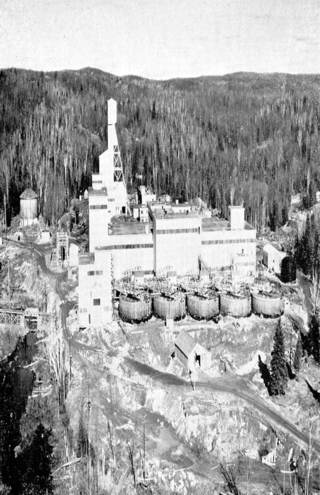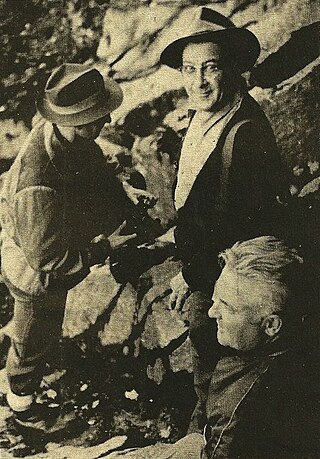
Elliot Lake is a city in Algoma District, Ontario, Canada. It is north of Lake Huron, midway between the cities of Sudbury and Sault Ste. Marie in the Northern Ontario region. Once dubbed the "uranium capital of the world," Elliot Lake has since diversified to a hub for forest harvesting, mine reclamation expertise, and advanced manufacturing. Elliot Lake is now known as a place for affordable retirement living, waterfront cottage lots and as a four-season destination.

Ovintiv Inc. is a hydrocarbon exploration and production company organized in Delaware and headquartered in Denver, United States. It was founded and headquartered in Calgary, Alberta, under its previous name Encana. It was the largest energy company and largest natural gas producer in Canada, before moving to the United States in 2020. The company was rebranded as Ovintiv and relocated to Denver in 2019–20.

Madawaska Mine (previously known as Faraday Mine) is a decommissioned underground uranium mine in Faraday, near the town of Bancroft, Ontario, which produced 9 million pounds (4,082 tonnes) of U3O8 concentrate, at an average ore grade of 0.1074%, during its two periods of production.

Faraday is a township in the Canadian province of Ontario, located within Hastings County adjacent to the town of Bancroft.
The Pronto Mine is an historical uranium mine located approximately 20 km south of Elliot Lake, Ontario near Spragge. The site is owned and operated by Rio Algom Ltd, has been rehabilitated and is currently undergoing environmental monitoring.

The Buckles Mine is an historical uranium mine located approximately 4.5 km southeast of Elliot Lake, Ontario, owned and operated by Rio Algom Ltd. The site has been rehabilitated. Environmental monitoring is ongoing as part of the monitoring for the nearby Nordic Mine.
The Can-Met Mine is an abandoned uranium mine located approximately 12.5 km northeast of Elliot Lake, Ontario, owned by Denison Mines Ltd. The site has been rehabilitated and its tailings facility is currently undergoing environmental monitoring by Denison Environmental Services.
The Lacnor Mine, is an abandoned uranium mine in the Elliot Lake area of Ontario, owned by Rio Algom Ltd. The site has been rehabilitated and its tailings facility is currently undergoing environmental monitoring by Denison Environmental Services.
Consolidated Denison Mine, or the Denison Mine is an abandoned uranium mine located approximately 12.5 km north of Elliot Lake, Ontario. The site is bordered north by Pronto Mine, Quirke Mine and Nordic Mine; on the east by Panel Mine and Can-Met Mine; and south by Spanish American Mine and Stanrock Mine.

Canada is the world's second largest producer of uranium, behind Kazakhstan. In 2009, 20% of the world's primary uranium production came from mines in Canada. 14.5% of the world production came from one mine, McArthur River. Currently the only producing area in Canada is northern Saskatchewan, although other areas have had active mines in the past.
The Agnew Lake Mine was a uranium mine located in the township of Hyman approximately 10 kilometres (6.2 mi) northeast of Agnew Lake, Ontario and 75 kilometres (47 mi) east of Elliot Lake, Ontario.

The successor of multiple historical Canadian mining and energy companies, EWL Management Limited was an Alberta based corporation that owned five decommissioned mines in Ontario, including three former uranium mines.

Bicroft Mine is a decommissioned underground uranium mine, located in Cardiff, near Bancroft, Ontario, Canada.

Dyno Mine is a decommissioned underground uranium mine located at Cardiff, near Farrel Lake, approximately 30km southwest of Bancroft, Ontario. It operated from 1958 to 1960.

Uranium mining around Bancroft, Ontario was conducted at four sites, beginning in the early 1950s and concluding by 1982. Bancroft was one of two major uranium-producing areas in Ontario, and one of seven in Canada, all located along the edge of the Canadian Shield. In the context of mining, the "Bancroft area" includes Haliburton, Hastings, and Renfrew counties, and all areas between Minden and Lake Clear. Activity in the mid-1950s was described by engineer A. S. Bayne in a 1977 report as the "greatest uranium prospecting rush in the world".

Arthur H. Shore was a mineral prospector and the first person set up a uranium mine in Faraday Township, Ontario. He co-founded and managed the Reeves feldspar Mine and founded the Faraday Uranium Mine. His uranium prospecting, according to Bayne in 1977, led to the "greatest uranium prospecting rush in the world."
Coldstream Copper Mine, sometimes called the North Coldstream Copper Mine, or the Coldstream Mine, or North Coldstream Mine is a decommissioned former copper, silver and gold mine adjacent to Burchell Lake. It is located 11km south of Kashabowie, in Northern Ontario, Canada.
Gordon Lake Mine was an underground copper mine near Werner Lake in the Kenora District of Ontario Canada.

Uranium mining in the Elliot Lake area represents one of two major uranium-producing areas in Ontario, and one of seven in Canada.














